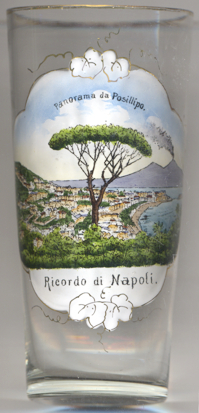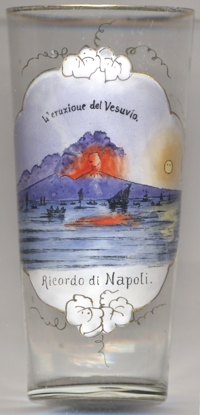

|
| ITALIA | ITALY |
| regione: Campania | Sardinia |
| città metropolitana: Napoli | metropolitan city: Naples |
Napoli (in English: Naples) is the regional capital of Campania and the third-largest city of Italy, after Rome and Milan with a population of about 909,000 within the city's administrative limits as of 2022. Its province-level municipality is the third-most populous metropolitan city in Italy with a population of some 3,115,300 residents, and its metropolitan area stretches beyond the boundaries of the city wall for approximately 30 kilometres.

 Founded by Greeks in the 1st millennium BC, Naples is one of the oldest continuously inhabited urban areas in the world. In the
8th century BC, a colony known as Parthenope (Ancient Greek: Παρθένοπη) was established
on the Pizzofalcone hill. In the 6th century BC, it was refounded as Neapolis. The city was an important part of Magna Graecia,
played a major role in the merging of Greek and Roman society, and was a significant cultural centre under the Romans. Naples served as the
capital of the Duchy of Naples (661–1139), subsequently as the capital of the Kingdom of Naples (1282–1816), and finally as the
capital of the Kingdom of the Two Sicilies — until the unification of Italy in 1861. Naples is also considered a capital
of the Baroque. It was also an important centre of humanism and Enlightenment. The city has long been a global point of reference for classical
music and opera through the Neapolitan School. Between 1925 and 1936, Naples was expanded and upgraded by the Fascist regime. During the later
years of World War II, it sustained severe damage from Allied bombing as they invaded the peninsula. The city underwent extensive
reconstruction work after the war. Naples' historic city centre is the largest in Europe and has been designated as a UNESCO World Heritage Site
(see list of other UNESCO Heritage sites of which there are souvenir glasses in this collection).
A wide range of culturally and historically significant sites are nearby, including the Palace of Caserta and the Roman ruins of Pompeii and
Herculaneum.
Founded by Greeks in the 1st millennium BC, Naples is one of the oldest continuously inhabited urban areas in the world. In the
8th century BC, a colony known as Parthenope (Ancient Greek: Παρθένοπη) was established
on the Pizzofalcone hill. In the 6th century BC, it was refounded as Neapolis. The city was an important part of Magna Graecia,
played a major role in the merging of Greek and Roman society, and was a significant cultural centre under the Romans. Naples served as the
capital of the Duchy of Naples (661–1139), subsequently as the capital of the Kingdom of Naples (1282–1816), and finally as the
capital of the Kingdom of the Two Sicilies — until the unification of Italy in 1861. Naples is also considered a capital
of the Baroque. It was also an important centre of humanism and Enlightenment. The city has long been a global point of reference for classical
music and opera through the Neapolitan School. Between 1925 and 1936, Naples was expanded and upgraded by the Fascist regime. During the later
years of World War II, it sustained severe damage from Allied bombing as they invaded the peninsula. The city underwent extensive
reconstruction work after the war. Naples' historic city centre is the largest in Europe and has been designated as a UNESCO World Heritage Site
(see list of other UNESCO Heritage sites of which there are souvenir glasses in this collection).
A wide range of culturally and historically significant sites are nearby, including the Palace of Caserta and the Roman ruins of Pompeii and
Herculaneum.
Glass no. 4647 [left] shows a  view from
view from
Glass no. 4648 [right] is decorated by a depiction of an  eruption
eruption
[https://en.wikipedia.org/wiki/Naples;
https://en.wikipedia.org/wiki/Posillipo;
https://en.wikipedia.org/wiki/Mount_Vesuvius]
![[scale]](lineal.jpg)